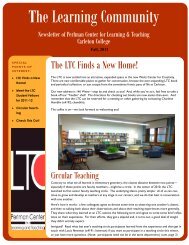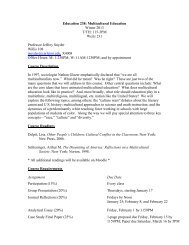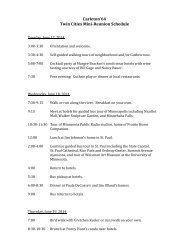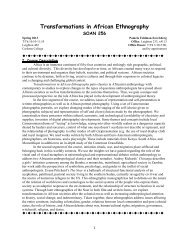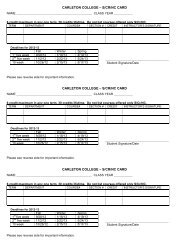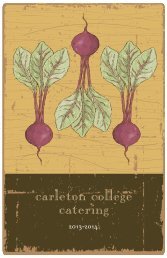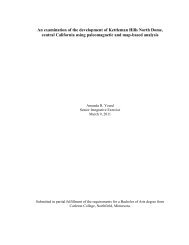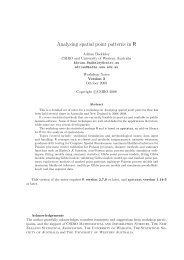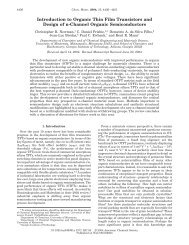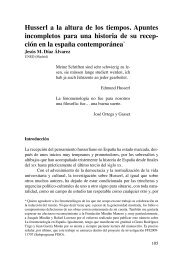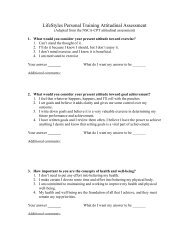Designing EcoHouse. - Carleton College
Designing EcoHouse. - Carleton College
Designing EcoHouse. - Carleton College
You also want an ePaper? Increase the reach of your titles
YUMPU automatically turns print PDFs into web optimized ePapers that Google loves.
HEATHER BEAL<br />
Above left: Instructors Richard Strong (shown) and Gary Wagenbach mix conventional classroom lectures with open and animated<br />
discussions to address issues that have “few prescribed solutions.” Above right: Students use “overlaying” to combine their individual<br />
research results and narrow site options for <strong>EcoHouse</strong>. Opposite: Noted green architect William McDonough, FAIA, joined <strong>EcoHouse</strong><br />
students for an informal discussion over breakfast in April 2004.<br />
<strong>Carleton</strong> officials first considered constructing an ecologically<br />
efficient student residence in 2002 after the college<br />
received a capital donation for this purpose. A short<br />
time later, a group of students completed an independent-study<br />
project that examined sustainable campus living.<br />
“Their project raised new questions,” Strong says.<br />
“Would college students want to live in an ecologically efficient<br />
house? What does sustainable mean? To find answers<br />
to these questions, we thought, ‘Why not design<br />
this house ourselves?’”<br />
After writing a preliminary course description,<br />
Strong invited other faculty members to consider<br />
collaborating with him. Wagenbach needed no cajoling.<br />
It made perfect sense for an architect (Strong)<br />
and a biologist (Wagenbach) to co-teach a course<br />
aimed at integrating the built and natural environments.<br />
However, as they soon learned, completing<br />
detailed plans for the <strong>EcoHouse</strong> class, which they<br />
envisioned teaching for up to five consecutive<br />
spring quarters, presented a number of challenges.<br />
A Tin-Foil Blanket<br />
At first students resist the idea of sustainable<br />
living,” Strong says. “Some think they’ll<br />
have to live in a cave with a candle. Others<br />
think they’ll have to shrink the size of their living<br />
space.” Strong and Wagenbach address these<br />
concerns by encouraging students to first think<br />
about how much space, daylight, heating, cooling,<br />
power, and other amenities they would need to<br />
make a home comfortable; then they ask the students<br />
to focus on achieving these goals sustainably.<br />
“Beauty and abundance are found in nature,”<br />
Strong assures them, “and thus are guiding principles<br />
for the design of <strong>EcoHouse</strong>.”<br />
Different teaching styles posed another challenge<br />
for the two instructors, who had never before<br />
collaborated. Wagenbach uses an empirical<br />
method, while Strong relies heavily on intuition.<br />
With a laugh, Strong recalls how Wagenbach once<br />
“wrapped a student in tin foil”—at least that’s<br />
what it looked like—to explore the concept of heat<br />
It made perfect sense for an architect (Strong) and<br />
a biologist (Wagenbach) to co-teach a course aimed at integrating<br />
the built and natural environments.<br />
HEATHER BEAL<br />
NOVEMBER – DECEMBER 2005 57



